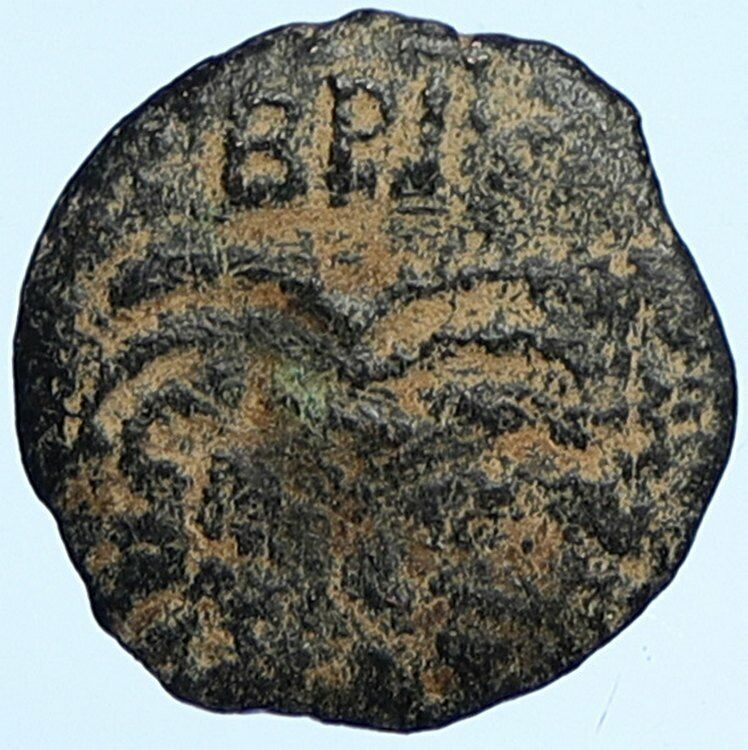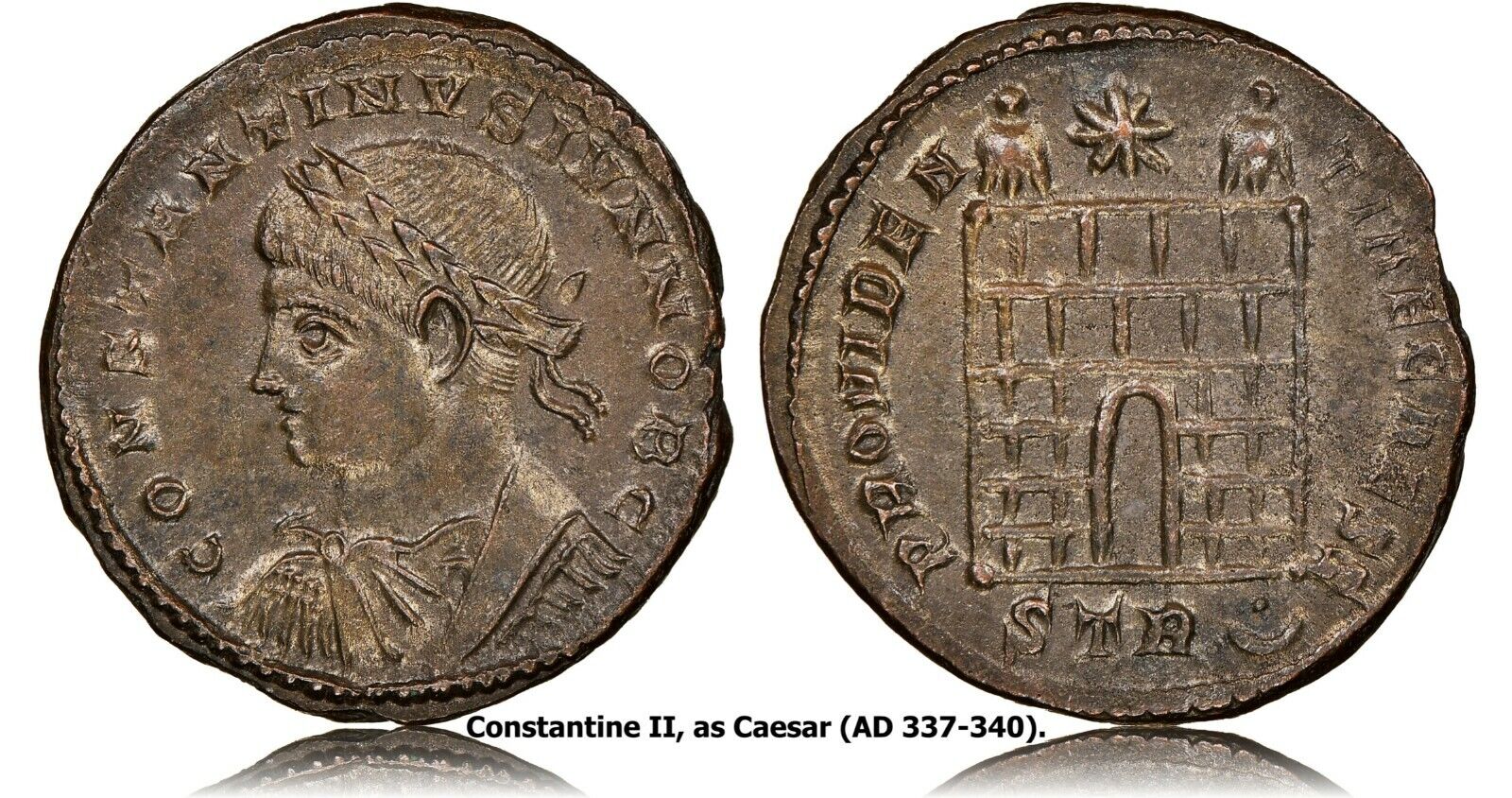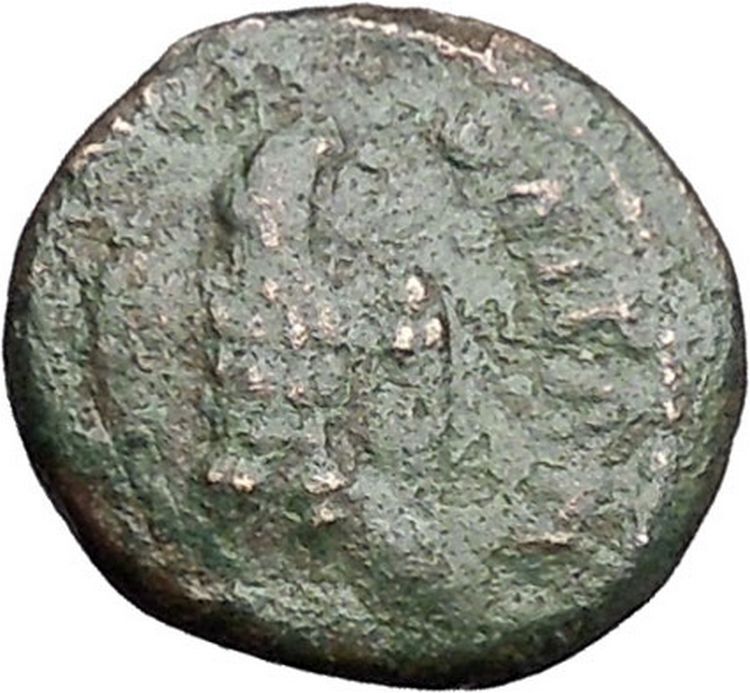-40%
JULIA MAMAEA Severus Alexander Wife RARE Pella Macedonia Roman Coin i34367
$ 79.2
- Description
- Size Guide
Description
Item:i34367
Authentic Ancient Coin of:
Julia Mamaea - Roman Empress wife of Emperor Severus Alexander 222-235 A.D. -
Bronze 26mm (9.25 grams) of Pella in Macedonia
IVLIA MAMAEA AVG - Draped bust right.
COL AVG PELLA - Pella city-goddess (Tyche) seated left.
You are bidding on the exact item pictured, provided with a Certificate of Authenticity and Lifetime Guarantee of Authenticity.
Pella
(
Greek
:
Πέλλα
), an ancient city located in
Pella Prefecture
of
Macedonia
in
Greece
, was the
capital
of the
ancient
kingdom
of
Macedon
. A common
folk etymology
is traditionally given for the name
Pella
, ascribing it to a form akin to the
Doric
Apella
, originally meaning a ceremonial location where decisions were made. However, the local form of Greek was not Doric, and the word exactly matches standard Greek
pélla
"stone", undoubtedly referring to a famous landmark from the time of its foundation.
//
History
The city was founded by
Archelaus
(413–
399 BC
) as the capital of his kingdom, replacing the older palace-city of
Aigai
(
Vergina
). After this, it was the seat of the king
Philip II
and of
Alexander
, his son. In
168 BC
, it was sacked by the
Romans
, and its treasury transported to
Rome
. Later, the city was destroyed by an
earthquake
and eventually was rebuilt over its ruins. By 180 AD,
Lucian
could describe it in passing as "now insignificant, with very few inhabitants".
Pella is first mentioned by
Herodotus
of Halicarnassus
(VII, 123) in relation to
Xerxes
' campaign and by
Thucydides
(II, 99,4 and 100,4) in relation to Macedonian expansion and the war against
Sitalces
, the king of the
Thracians
. According to
Xenophon
, in the beginning of the 4th century BC, it was the largest Macedonian city. It was probably built as the capital of the kingdom by Archelaus, although there appears to be some possibility that it may have been
Amyntas
. It attracted Greek artists such the painter
Zeuxis
, the poet
Timotheus
of Miletus
and the
tragic author
Euripides
who finishes his days there writing and producing
Archelaus
.
Archelaus invited the painter
Zeuxis
, the greatest painter of the time, to decorate it. He was later the host of the Athenian playwright
Euripides
in his retirement. Euripides
Bacchae
premiered here, about
408 BC
. Pella was the birthplace of Philip II and of Alexander, his son. The hilltop
palace
of Philip, where
Aristotle
tutored young Alexander, is being excavated.
In antiquity, Pella was a port connected to the
Thermaic Gulf
by a navigable
inlet
, but the harbor has silted, leaving the site landlocked. The reign of
Antigonus
likely represented the height of the city, as this is the period which has left us the most archaeological remains.
Pella is further mentioned by
Polybius
and
Livy
as the capital of
Philip V
and of
Perseus
during the
Macedonian Wars
, fought against the
Roman Republic
. In the writings of Livy, we find the only description of how the city looked in
167 BC
to
Lucius Aemilius Paulus Macedonicus
, the Roman who defeated Perseus at the
battle
of Pydna
:
…[Paulus] observed that it was not without good reason that it had been chosen as the royal residence. It is situated on the south-west slope of a hill and surrounded by a marsh too deep to be crossed on foot either in summer or winter. The citadel the "Phacus," which is close to the city, stands in the marsh itself, projecting like an island, and is built on a huge substructure which is strong enough to carry a wall and prevent any damage from the infiltration from the water of the lagoon. At a distance it appears to be continuous with the city wall, but it is really separated by a channel which flows between the two walls and is connected with the city by a bridge. Thus it cuts off all means of access from an external foe, and if the king shut anyone up there, there could be no possibility of escape except by the bridge, which could be very easily guarded..
[3]
The famous poet
Aratus
died in Pella
ca
240 BC
. Pella was sacked by the Romans in
168 BC
, when its treasury was transported to Rome.
In the
Roman province of Macedonia
, Pella was the capital of the third district, and was possibly the seat of the Roman governor. Crossed by the
Via Egnatia
[4]
, Pella remained a significant point on the route between
Dyrrachium
and
Thessalonika
.
Cicero
stayed there in
58 BC
, but by then the provincial seat had already transferred to Thessalonika. It was then destroyed by earthquake in the first century BC; shops and workshops dating from the catastrophe have been found with remains of their merchandise. The city was eventually rebuilt over its ruins, which preserved them, but,
ca
AD 180
,
Lucian
of
Samosata
could describe it in passing as "now insignificant, with very few inhabitants"
The city went into decline for reasons unknown (possibly an earthquake) by the end of the 1st century BC. It was the object of a colonial deduction sometime between 45 and
30 BC
; in any case currency was marked
Colonia Iulia Augusta Pella
.
Augustus
settled peasants there whose land he had usurped to give to his veterans (
Dio Cassius
LI, 4). But unlike other Macedonian colonies such as
Philippi
,
Dion
, and
Cassandreia
it never came under the jurisdiction of
ius Italicum
or Roman law. Four pairs of colonial magistrates (
IIvirs quinquennales
) are known for this period.
The decline of the city was rapid, in spite of colonization:
Dio Chrysostom
(
33.27
Or.
) and
Lucian
both attest to the ruin of the ancient capital of Philip II and Alexander; though their accounts may be exaggerated. In fact, the Roman city was somewhat to the west of and distinct from the original capital; which explains some contradictions between coinage,
epigraphs
, and testimonial accounts. In the Byzantine period, the Roman site was occupied by a fortified village.
The site
Urban area
The city is built on the
island
of Phacos
, a
promontory
which dominates the wetlands which encircle Pella to the south, and a lake which opened to the sea in the
Hellenistic period
.
Palace
The city wall mentioned by Livy is only partly known. It consists of a rampart of crude bricks (about 50 cm square) raised on a stone foundation; some of which has been located North of the palace, and some in the South next to the lake. Inside the ramparts, three hills occupy the North, and the palace is situated on a place of honour on the central hill. Partly searched, it occupied a considerable area of perhaps 60,000 square metres). The plan is still not well known, but has been related to that of the city plan (see diagram).
The Pella palace consisted of several — possibly seven — large architectural groupings juxtaposed in two rows, each including a series of rooms arranged around a central square courtyard, generally with porticos. Archaeologists have thus far identified a
palaestra
and
baths
. The south facade of the palace, towards the city, consisted of one large (at least 153 metres long) portico, constructed on a two metres high foundation. The relationship between the four principal complexes is defined by an interruption in the portico occuupied by a triple
propylaeum
, 15 m high, which gave the palace an imposing monumental air when seen from the city below.
Dating of the palace has posed some problems: the large buildings could date the reign of Philip II, but other buildings appear to be earlier. The baths date from the reign of
Cassander
.
The size of the complex indicates that, unlike the palace at Vergina, this was not only a royal residence or a grandiose monument but also a place of government which was required to accommodate a portion of the administrative apparatus of the kingdom.
Hippodamean plan
The city proper was located south of and below the palace. Designed on a
grid plan
as envisaged by
Hippodamus
, it consists of two series of parallel streets which intersect at right angles and form a grid of eight rows of rectangular blocks. These blocks are of a consistent width — each approximately 45 m — and a length which varies from 111 m to 152 m, 125 metres being the most common. The streets are from 9 to 10 metres wide, except for the middle East–West arterial, which is up to 15 metres wide. This street is the primary access to the central public
agora
, which occupied a space of ten blocks. Two North-South streets area also a bit wider than the rest, and serve to connect the city to the port further South. The streets had sewers and were equipped to convey water to individual residences.
Lion Hunt Mosaic in Pella
This type of plan dates to the first half of the fourth century BC, and is very close to the ideal in design, though it distinguishes itself by large block size;
Olynthus
in
Chalcidice
for example had blocks of 86.3×35 metres. On the other hand, later Hellenistic urban foundations have blocks comparable to those of Pella: 112×58 m in
Laodicea ad Mare
, or 120×46 m in
Aleppo
.
The agora holds pride of place in the centre of the city, occupying an imposing 200 by 181 metres; 262×238 metres if one counts the potrticos which surround it on all sides.
Archaeology
Based on the descriptions provided by
Titus Livius
, the site was explored by 19th-century voyagers including Holand, Pouqueville, Beaujour, Cousinéry, Delacoulonche, Hahn, Glotz and Struck. The first excavation was begun by G. Oikonomos in 1914–15. The modern systematic exploration of the site began in 1953 and full excavation was being done in 1957. The first series of campaigns were completed in 1963, more excavations following in 1980. These digs continue in the section identified as the agora.
In February 2006, a farmer accidentally uncovered the largest tomb ever found in Greece. The names of the noble
ancient Macedonian
family are still on inscriptions and painted sculptures and walls have survived. The tomb dates to the
2nd
or 3rd century BC, following the rule of Alexander the Great.
An atrium with a pebble-mosaic paving
Archaeological digs in progress since 1957 have uncovered a small part of the city, which was made rich by Alexander and his heirs. The large agora or market was surrounded by the shaded colonnades of
stoae
, and streets of enclosed houses with frescoed walls round inner courtyards. The first
trompe-l'oeil
wall murals imitating perspective views ever seen were on walls at Pella. There are
temples
to
Aphrodite
,
Demeter
and
Cybele
, and Pella's
pebble-mosaic floors
, dating after the lifetime of Alexander, are famous: some reproduce Greek paintings; one shows a lion-griffin attacking a stag, a familiar motif also of
Scythian
art, another depicts
Dionysus
riding a leopard.
Julia Avita Mamaea
(14 or 29 August after 180–235) was the second daughter of
Julia Maesa
, a powerful
Roman woman
of
Syrian
Arab
origin and Syrian noble
Julius Avitus
. She was a niece of empress
Julia Domna
and
emperor
Septimius Severus
and sister of
Julia Soaemias
. She was born and raised in
Emesa
(modern
Homs
,
Syria
).
Julia's first husband was a former consul (whose name is unknown) who died. Julia married as her second husband Syrian
Promagistrate
Marcus Julius Gessius Marcianus
. Julia bore Marcianus two children, a daughter called Theoclia (little is known of her) and a son, Marcus Julius Gessius Bassianus Alexianus, later emperor
Alexander Severus
. Unlike her sister, Julia Mamaea was reported to be a virtuous woman, never involved in scandals.
As a member of the Imperial Roman family, she watched closely the death of her cousin
Caracalla
and the ascent to power of her nephew
Elagabalus
, the oldest grandson of Julia Maesa and her choice to the throne. Eventually Elagabalus and his mother Julia Soaemias proved incompetent rulers and favour fell on Alexander, Julia's son. He became emperor in 222, following Elagabalus' murder by the
Praetorian Guard
. Julia and her mother became regents in the name of Alexander, then 14 years old. Upon adulthood, Alexander confirmed his esteem for his mother and named her
consors imperii
(imperial consort). It was in this condition that she accompanied her son in his campaigns: a custom started with
Julia Domna
. Thus she travelled to the East, for the campaign against
Parthia
and to the Germania provinces. Julia Mamaea was with Alexander in Moguntiacum (modern
Mainz
), capital of
Germania Superior
, when he was assassinated by his troops. She suffered the same fate.
Frequently Asked Questions
How long until my order is shipped?
Depending on the volume of sales, it may take up to 5 business days for shipment of your order after the receipt of payment.
How will I know when the order was shipped?
After your order has shipped, you will be left positive feedback, and that date should be used as a basis of estimating an arrival date.
After you shipped the order, how long will the mail take?
USPS First Class mail takes about 3-5 business days to arrive in the U.S., international shipping times cannot be estimated as they vary from country to country. I am not responsible for any USPS delivery delays, especially for an international package.
What is a certificate of authenticity and what guarantees do you give that the item is authentic?
Each of the items sold here, is provided with a Certificate of Authenticity, and a Lifetime Guarantee of Authenticity, issued by a world-renowned numismatic and antique expert that has identified over 10000 ancient coins and has provided them with the same guarantee. You will be quite happy with what you get with the COA; a professional presentation of the coin, with all of the relevant information and a picture of the coin you saw in the listing.
Compared to other certification companies, the certificate of authenticity is a -50 value. So buy a coin today and own a piece of history, guaranteed.
Is there a money back guarantee?
I offer a 30 day unconditional money back guarantee. I stand behind my coins and would be willing to exchange your order for either store credit towards other coins, or refund, minus shipping expenses, within 30 days from the receipt of your order. My goal is to have the returning customers for a lifetime, and I am so sure in my coins, their authenticity, numismatic value and beauty, I can offer such a guarantee.
Is there a number I can call you with questions about my order?
You can contact me directly via ask seller a question and request my telephone number, or go to my About Me Page to get my contact information only in regards to items purchased on eBay.
When should I leave feedback?
Once you receive your order, please leave a positive. Please don't leave any negative feedbacks, as it happens many times that people rush to leave feedback before letting sufficient time for the order to arrive. Also, if you sent an email, make sure to check for my reply in your messages before claiming that you didn't receive a response. The matter of fact is that any issues can be resolved, as reputation is most important to me. My goal is to provide superior products and quality of service.











